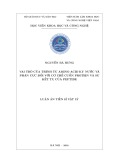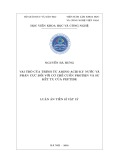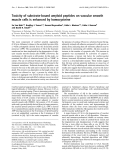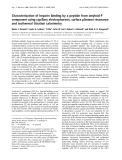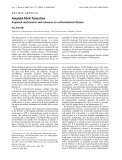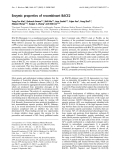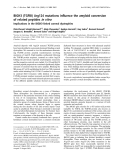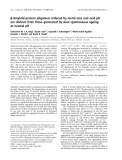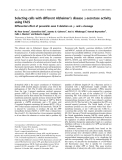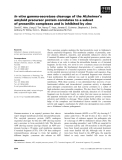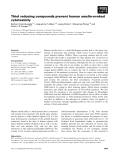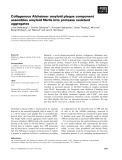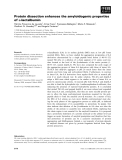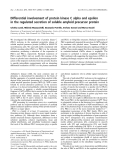
Amyloid protein
-
Luận án được chia làm 5 chương được trình bày như sau: giới thiệu tổng quan về vấn đề cuốn protein; giới thiệu tổng quan về hiện tượng kết tụ protein và sự hình thành amyloid; đề cập đến các mô hình, phương pháp mô phỏng và phương pháp xử lý số liệu; trình bày kết quả nghiên cứu về vai trò của trình tự HP đối với cơ chế cuốn protein; trình bày kết quả nghiên cứu vai trò của trình tự HP đối với sự kết tụ của peptide.
 123p
123p  phongtitriet000
phongtitriet000
 08-08-2019
08-08-2019
 56
56
 4
4
 Download
Download
-
Nội dung luận án được chia làm 5 chương không kể các phần mở đầu, kết luận và tài liệu tham khảo. Chương 1 giới thiệu tổng quan về vấn đề cuốn protein. Chương 2 giới thiệu tổng quan về hiện tượng kết tụ protein và sự hình thành amyloid. Chương 3 đề cập đến các mô hình, phương pháp mô phỏng và phương pháp xử lý số liệu. Chương 4 trình bày kết quả nghiên cứu về vai trò của trình tự HP đối với cuốn protein. Chương 5 trình bày kết quả nghiên cứu vai trò của trình tự HP đối với sự kết tụ của peptide.
 123p
123p  xacxuoc4321
xacxuoc4321
 09-07-2019
09-07-2019
 41
41
 5
5
 Download
Download
-
Nội dung luận án được chia làm 5 chương không kể các phần mở đầu, kết luận và tài liệu tham khảo. Chương 1 giới thiệu tổng quan về vấn đề cuốn protein. Chương 2 giới thiệu tổng quan về hiện tượng kết tụ protein và sự hình thành amyloid. Chương 3 đề cập đến các mô hình, phương pháp mô phỏng và phương pháp xử lý số liệu. Chương 4 trình bày kết quả nghiên cứu về vai trò của trình tự HP đối với cuốn protein. Chương 5 trình bày kết quả nghiên cứu vai trò của trình tự HP đối với sự kết tụ của peptide.
 34p
34p  xacxuoc4321
xacxuoc4321
 09-07-2019
09-07-2019
 41
41
 4
4
 Download
Download
-
The main component of cerebral amyloid angiopathy (CAA) in Alzheimer’s disease is the amyloid-b protein (Ab), a 4-kDa polypeptide derived from the b-amyloid protein precursor (APP). The accumulation of Ab in the basement membrane has been implicated in the degeneration of adjacent vascular smooth muscle cells (VSMC). However, the mechanism of Ab toxicity is still unclear. In this study, we examined the effect of substrate-bound Ab on VSMC in culture. The use of substrate-bound proteins in cell culture mimics presentation of the proteins to cells as if bound to the basement membrane.
 9p
9p  system191
system191
 01-06-2013
01-06-2013
 44
44
 5
5
 Download
Download
-
Division of Medicinal and Natural Products Chemistry, Department of Chemistry and Department of Chemical Engineering, University of Iowa, USA; 2Department of Autoimmunology, Statens Serum Institut, Copenhagen, Denmark Synthetic peptides based on amino-acid residues 27–38 of human serum amyloid P component represent a novel type of heparin binders as they do not contain clusters of basic amino acids or other known features associated with protein or peptide heparin binding.
 8p
8p  system191
system191
 01-06-2013
01-06-2013
 56
56
 4
4
 Download
Download
-
The phenomenon of the transformation of proteins into amyloid-fibrils is of interest, firstly, because it is closely connected to the so-called conformational diseases, many of which are hitherto incurable, and secondly, because it remains to be explained in physical terms (energetically and structurally). The process leads to fibrous aggregates in the form of extracellular amyloid plaques, neuro-fibrillary tangles and other intracytoplasmic or intranuclear inclusions.
 10p
10p  research12
research12
 01-06-2013
01-06-2013
 33
33
 4
4
 Download
Download
-
The amyloid protein precursor (APP) was incorporated into liposomes or phospholipid monolayers. APP insertion into liposomes required neutral lipids, such as L-a-phosphatidylcholine, in the target membrane. It was prevented in vesicles containing L-a-phosphatidylserine. The insertion was enhanced in acidic solutions, suggesting that it is modulated by specific charge/charge interactions. Surfaceactive properties and behaviour of APP were characterized during insertion of the protein in monomolecular films of L-a-phosphatidylcholine, L-a-phosphatidylethanolamine or L-a-phosphatidylserine. ...
 9p
9p  research12
research12
 01-06-2013
01-06-2013
 46
46
 5
5
 Download
Download
-
BACE2 (Memapsin 1) is a membrane-bound aspartic pro-tease that is highlyhomologouswithBACE1 (Memapsin 2). While BACE1 processes the amyloid precursor protein (APP) at a key step in generating theb-amyloid peptide and presumably causes Alzheimer’s disease (AD), BACE2 has not been demonstrated to be directly involved in APP pro-cessing, and its physiological functions remain to be deter-mined.In vivo, BACE2 is expressed as a precursor protein containing pre-, pro-, protease, transmembrane, and cyto-solic domains/peptides....
 10p
10p  tumor12
tumor12
 22-04-2013
22-04-2013
 26
26
 2
2
 Download
Download
-
Amyloid deposits with Arg124 mutated TGFBI protein havebeen identified inautosomal dominant blindingcorneal dystrophies.We assessedin vitrothe mechanisms determin-ing TGFBI protein amyloid transformation involving mutations of Arg124.Eight peptides synthesized following the TGFBI protein sequence, centered on codon Arg124 holding the previously reported amyloidogenic mutations and the respective controls were studied.Cys124 andHis124 mutated peptide preparations contained significantly higher amounts of amyloid than the native peptide....
 8p
8p  tumor12
tumor12
 22-04-2013
22-04-2013
 42
42
 2
2
 Download
Download
-
Amyloid protein (Ab1–40) aggregation and conformation was examined using native and sodium dodecyl sulfate/ polyacrylamide gel electrophoresis,and the results com-pared with those obtained by atomic force microscopy, and with Congo red binding,sedimentation and turbidity assays. The amount of Ab aggregation measured was different,depending upon the method used. Incubation for 15 min at pH 5.0 or in the presence of Fe 2+ ,Cu 2+ or Zn 2+ did not alter the level of Aboligomers observed on SDS and native gels....
 12p
12p  tumor12
tumor12
 20-04-2013
20-04-2013
 43
43
 4
4
 Download
Download
-
Theb-amyloid peptide (Ab) is a major component of toxic amyloid plaques found in the brains of patients with Alzheimer’s disease.Abis liberated by sequential cleavage of amyloid precursor protein (APP) byb-andc-secre-tases.The level of Abdepends directly on the hydrolytic activity ofb-secretase.Therefore, b-secretase is an excel-lent target for drug design.An approach based on RNA-cleaving ribozymes was developed to control expression ofb-secretase.
 9p
9p  tumor12
tumor12
 20-04-2013
20-04-2013
 38
38
 4
4
 Download
Download
-
The ultimate step in Alzheimer’s disease Abgeneration involves c-secretase, which releases Abfrom its membrane-bound precursor. Asimilar presenilin-dependent proteolytic activity is implicated in the release of theNotch intracellular domain. We have developed a novel assay forc-secretase activity based on green fluorescent protein detection. This involves cotransfection of a substrate-activator based on the amyloid precursor protein or the Notch sequence and a fluorescent reporter gene.
 12p
12p  tumor12
tumor12
 20-04-2013
20-04-2013
 33
33
 4
4
 Download
Download
-
Thec-secretase complex mediates the final proteolytic event in Alzheimer’s disease amyloid-bbiogenesis. This membrane complex of presenilin, ante-rior pharynx defective, nicastrin, and presenilin enhancer-2 cleaves the C-terminal 99-amino acid fragment of the amyloid precursor protein intra-membranously atc-sites to form C-terminally heterogeneous amyloid-b and cleaves at ane-site to release the intracellular domain or e-C-terminal fragment.
 14p
14p  fptmusic
fptmusic
 12-04-2013
12-04-2013
 42
42
 5
5
 Download
Download
-
Human amylin (hA) is a small fibrillogenic protein that is the major con-stituent of pancreatic islet amyloid, which occurs in most subjects with type-2 diabetes mellitus (T2Dm). There is growing evidence that hA toxic-ity towards islet b-cells is responsible for their gradual loss of function in T2Dm. Preventing hA-mediated cytotoxicity has been proposed as a route to halt the progression of this disease, although this has not yet been dem-onstratedin vivo.
 11p
11p  fptmusic
fptmusic
 12-04-2013
12-04-2013
 33
33
 2
2
 Download
Download
-
Protein aggregation is central to most neurodegenerative diseases, as shown by familial case studies and by animal models. A modified ‘amyloid cas-cade’ hypothesis for Alzheimer’s disease states that prefibrillar oligomers, also called amyloid-b-derived diffusible ligands or globular oligomers, are the responsible toxic agent. It has been proposed that these oligomeric spe-cies, as shown for amyloid-b, b2 -microglobulin or prion fragments, exert toxicity by forming pores in membranes, initiating a cascade of detrimental events for the cell. ...
 10p
10p  awards
awards
 06-04-2013
06-04-2013
 42
42
 3
3
 Download
Download
-
Neurodegenerative disorders, such as Huntington’s, Alzheimer’s, and Parkinson’s diseases, affect millions of people worldwide and currently there are few effective treatments and no cures for these diseases. Transgenic mice expressing human transgenes for huntingtin, amyloid precursor protein, and other genes associated with familial forms of neurodegenerative disease in humans provide remarkable tools for studying neurodegeneration because they mimic many of the pathological and behavioural features of the human conditions. ...
 15p
15p  awards
awards
 06-04-2013
06-04-2013
 39
39
 4
4
 Download
Download
-
Recently, a novel plaque-associated protein, collagenous Alzheimer amy-loid plaque component (CLAC), was identified in brains from patients with Alzheimer’s disease. CLAC is derived from a type II transmembrane colla-gen precursor protein, termed CLAC-P (collagen XXV). The biological function and the contribution of CLAC to the pathogenesis of Alzheimer’s disease and plaque formation are unknown.
 0p
0p  awards
awards
 06-04-2013
06-04-2013
 31
31
 2
2
 Download
Download
-
a-lactalbumin (LA) in its molten globule (MG) state at low pH forms amyloid fibrils. Here, we have studied the aggregation propensities of LA derivatives characterized by a single peptide bond fission (1–40⁄41–123, named Th1-LA) or a deletion of a chain segment of 12 amino acid resi-dues located at the level of the b-subdomain of the native protein (1– 40⁄53–123, named desb-LA). We have also compared the early stages of the aggregation process of these LA derivatives with those of intact LA....
 13p
13p  awards
awards
 06-04-2013
06-04-2013
 39
39
 2
2
 Download
Download
-
We investigated the differential role of protein kinase C (PKC) isoforms in the regulated proteolytic release of soluble amyloid precursor protein (sAPPa)inSH-SY5Y neuroblastoma cells. We used cells stably transfected with cDNAs encoding either PKCaor PKCein the antisense orientation, producing a reduction of the expression of PKCa and PKCe, respectively. Reduced expression of PKCaand/or PKCedid not modify the response of the kinase to phorbol ester stimulation, demonstrating translo...
 8p
8p  awards
awards
 05-04-2013
05-04-2013
 46
46
 5
5
 Download
Download
-
Numerous transmembrane proteins, including the blood pressure regulating angiotensin converting enzyme (ACE) and the Alzheimer’s disease amyloid precursor protein (APP), are proteolytically shed from the plasma membrane by metalloproteases. We have used an antisense oligo-nucleotide (ASO) approach to delineate the role of ADAM10 and tumour necrosis factor-aconverting enzyme (TACE;ADAM17) in theectodomainsheddingofACEand APP from human SH-SY5Y cells.
 9p
9p  dell39
dell39
 03-04-2013
03-04-2013
 57
57
 3
3
 Download
Download
CHỦ ĐỀ BẠN MUỐN TÌM









